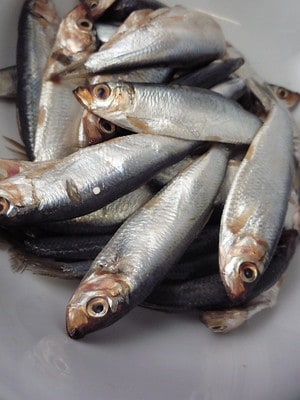Sprats are NOT a vegetable but a type of fish for those who have just heard the word.
As we all know, fish are excellent sources of various nutrients such as Omega-3 fatty acids, protein, and calcium, to name a few.
Sprats are excellent sources of multiple vitamins, protein, and healthy fats (which we will break down in just a bit).
Now, you might wonder: Can my furry pal have sprats as part of their meal plans?
How often can they be given sprats?
Or are sprats safe for dogs to eat?
My friend, we’re one step ahead of you.
In this article, we’ll be going over everything you need to know about sprats, their safety to eat for dogs, nutritional info, and more!
Without further ado, let’s dive right into it!
What type of fish are sprats?
At first glance, you may think it’s anything but a fish, as some may have never heard of it (until today). Sprats, also known as Bristling, is a consumable fish from the herring family Clupeidae. They are typically silver-colored and swim in schools across the western European waters.
Sprats are pretty tiny compared to Atlantic herrings. They are only about 6 inches long, making them perfect for canning, just like your regular sardines. There are various ways to eat sprats, including tinned in oil, smoked, or eaten fresh (whichever works, really).
What nutrition do they offer to dogs?
When it comes to our beloved tail-wagging companions, health is indeed wealth. As owners, we want to ensure our dogs get the most out of their food to benefit their growth and fitness and always be on ready mode for park jogs. Sprats might just be a potential contributor to your dog’s diet.
Believe it or not, Sprats may be an excellent food option if your dog is on a diet. It contains zero carbs, fiber, and sugar! For every 100 grams, this fish has about 160 calories per serving, p23 grams of protein (to build on those muscles), and has plenty of Omega-3 and Omega-6 to maintain a healthy immune system, lungs, blood vessels, and big hearts.
Sprats are packed with a variety of vitamins, which include Vitamin B12 (for healthy blood and nerve cells), Niacin or B3 (lowers cholesterol), Vitamin D (maintain healthy and strong bones and muscles), and many more! To put the cherry on top, Sprats are abundant in various minerals as well, particularly Selenium (improve cognition and immunity), Phosphorus (for sturdy bones), and Zinc (improves metabolism).
Could they in any way be dangerous for dogs?
Like any raw food, there is always a contamination risk, and possible food poisoning should you choose to buy and feed raw Sprats for your furry pal. You must know where you buy frozen Sprats from and that they have been handled hygienically. To be safe, you can wash frozen Sprats with cold water to avoid defrosting. Then dry them to mitigate the risks of bacterial contamination.
Rest assured, Sprats are generally considered a safe treat for your furry friends as they are thoroughly processed to ensure safe consumption. However, it is wise to avoid feeding them if your furry friend is overweight or has a bowel condition due to the relatively high-fat content. Doing so will minimize the risks of further complications of conditions that are worsened by consuming high-fat content foods.
In the case of adorable pups, you can feed them Sprats as long as they are at least 12 weeks old. To safely feed them, ensure that you break the fish down to smaller and chewable sizes and feed them in moderation to ensure your pup has a well-balanced diet as they grow.
How big are the bones in sprats?
As most of us, including our furry pals, have had some kind of fish before, the one thing we always keep an eye out for is those annoying bones that get stuck on our teeth. Though Sprats are eaten as a whole, with the bones, they are tiny and are no thicker than a strand of hair! With that being said, your dogs can easily munch and digest them without the need to worry about the risks of blockages compared to other fishes with large bones.
Sprats: Raw vs. Air-dried vs. Frozen vs. Smoked vs. Cooked
There are various ways you can serve and feed sprats to your fellow furry compadres. These include raw, air-dried, frozen, smoked, and cooked. While dogs may have particularcertain preferences in eating sprats, each of these serving methods has its own ups and downs to consider.
Raw
Like most fresh foods, serving sprats raw means retaining most of its nutrients without being broken down or decreased due to being processed or cooked. Sprats can also make a great addition if your furry pal’s on a raw food diet.
As mentioned, raw sprats pose a risk for bacterial contamination and a subsequent food poisoning episode (yikes). With that being said, you should always ensure you know where you buy your sprats and how the environment where they are being handled in. Though doing so does not guarantee a risk-free meal, it minimizes the chances of contamination compared to less hygienic selling outlets.
Air-dried
A popular serving style and perhaps a personal favorite for most dogs. Why? Air-dried sprats are gently fried with zero heat, resulting in a crunchy treat for your friend in paws. The best part is that air-dried sprats are easily broken through, making them great to use when training your dogs. On top of that, air-drying sprats also helps mitigate the risks of contamination of bacteria and can even help maintain your dog’s dental health (believe it or not).
Due to its high-fat contents, it may be unsuitable for overweight dogs or have underlying health issues such as inflammatory bowel disease or pancreatitis. Feeding them air-dried Sprats will only make things worse.
Frozen
Frozen sprats is a great alternative to raw ones for either an unprocessed treat or as an additional nutrition boost on your dog’s raw food plan. It is vital that your dog immediately eats them as the fish may defrost over time when left for long periods. Ensure you wash or rinse the fish with cold water (to avoid it from defrosting) before you feed it to your tail-wagging pal. With that being said, the only downside is the possibility of a fishy smell if your dog doesn’t eat it fast enough, which may linger if left unattended.
Smoked
The fact that smoking sprats involves relatively high heat means hasta la vista (or goodbye) to disease-causing bacteria. On top of that, it easily smokes out most cooking style methods (no pun intended) when it comes to life shelf, as smoking sprats can keep it preserved a little longer than most cooking methods. The drawback, however, is potentially high levels of sodium. If you don’t know already, high sodium may cause diarrhea (nope, just nope), vomiting, dehydration, and seizures (in worst cases) in dogs.
Cooked
If there’s one way to be sure of getting rid of bacteria, it’s through cooking it thoroughly! Not only is it the best risk mitigator, but it is also one way of unleashing the dog chef within you! Instead of just serving the fish raw, there are plenty of recipes out there for you to try and have your furry Masterchef judge your performance. The only downside is the loss of nutrients as heat tends to break down and decrease the nutrient levels compared to when it’s uncooked and unprocessed.
Where can I buy sprats from?
You may find them at your local grocery store, but if you’re looking for some branded and processed ones just to be safe, there are some brands you can consider. Here are the top three sprats brands you can choose from:
Note: before you choose to purchase any of these brands, we highly recommend seeking professional advice from your local vet to ensure the treat is suited for your furry friend’s health and wellbeing.
Sprats vs. Mackarel
If you’re ever in a dilemma on which fish is best, this section is just for you. Though both of these fishes have similar nutritional values, there are some differences to keep in mind.
Nutrition
Sprats may have the upper hand in nutrition as they have 30 calories less than mackerels, have zero sodium (which may cause health problems in high amounts), and have 5 grams of fat less than mackerels. On top of that, though sprats may be smaller in length, they pack 23 grams of protein than mackerels at only 19 grams.
Price
Though there is only a slight difference between the price of mackerels and sprats, mackerels are generally cheaper than sprats. There has been a noticeable increase in the price of mackerels that you may want to keep an eye for when shopping for your groceries.
Availability
Sprats may be relatively more challenging to find in grocery stores than mackerels and are less readily available than mackerels. However, with the digital era, we live in, we can find and purchase these two fish online from various brands and online shops.
How can I store sprats?
If your furry pal doesn’t happen to be in the mood for a fishy treat, or if you simply want to save your sprats for another day, storing them properly would enable you to do just that without worrying for the fishes to go to ruin. For proper storage and to maximize the shelf life of sprats, keep them refrigerated and covered in a glass or plastic container. These stored sprats can last between 3 and 4 days at most.
What types of dogs shouldn’t eat sprats?
While sprats are excellent sources of vitamins, minerals, and protein, certain types of dogs may be unsuited to eat sprats in the first place. They include dogs who are or have:
- Pregnant (on a side note: congrats!)
- Fast eaters
- Puppies under 12 weeks old
- Overweight dogs (due to high-fat content despite the low calories)
- Underlying health conditions (such as pancreatitis and bowel movement problems)
Note: Every dog is different in its own way; this includes how they respond to certain foods. Please consult with your local vet to discuss whether sprats are a good fit for their diet or if they should be avoided at all costs.
How many sprats should I feed my dog?
Though there are no known guidelines on how many sprats your furry pal can devour in a day, two to three dried sprats a day is the recommended portion. If you’re feeding them frozen sprats, then you can go another one or two more sprats. A general rule of thumb is to consider sprats as treats, something you give occasionally and not excessively.
As a responsible doggo owner, knowing everything about any food, especially when it’s new for your furry pal, is a wise and thoughtful thing to do. It is also important that you keep your furryf friend’s medical history in mind, such as their current weight, underlying health conditions (if any), and current meal plans. Though this article may seem like a stretch, taking a few notes may greatly benefit you when selecting whether or not sprats are safe to consume and add onto their diet.







